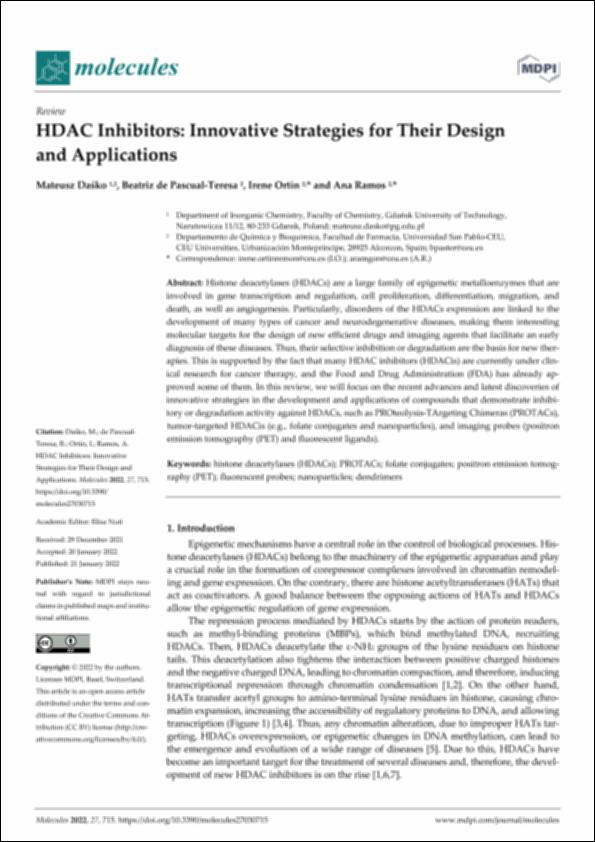Por favor, use este identificador para citar o enlazar este ítem:
http://hdl.handle.net/10637/13385HDAC Inhibitors: Innovative Strategies for Their Design and Applications.
| Título : | HDAC Inhibitors: Innovative Strategies for Their Design and Applications. |
| Autor : | Dasko, Mateusz Ramos González, Ana Coderch Boué, Claire Pascual-Teresa Fernández, Beatriz de |
| Materias: | Histone deacetylases (HDACs); PROTACs; Folate conjugates; Positron emission tomography (PET); Fluorescent probes; Dendrimers; Nanoparticles |
| Resumen : | Histone deacetylases (HDACs) are a large family of epigenetic metalloenzymes that are involved in gene transcription and regulation, cell proliferation, differentiation, migration, and death, as well as angiogenesis. Particularly, disorders of the HDACs expression are linked to the development of many types of cancer and neurodegenerative diseases, making them interesting molecular targets for the design of new efficient drugs and imaging agents that facilitate an early diagnosis of these diseases. Thus, their selective inhibition or degradation are the basis for new therapies. This is supported by the fact that many HDAC inhibitors (HDACis) are currently under clinical research for cancer therapy, and the Food and Drug Administration (FDA) has already approved some of them. In this review, we will focus on the recent advances and latest discoveries of innovative strategies in the development and applications of compounds that demonstrate inhibitory or degradation activity against HDACs, such as PROteolysis-TArgeting Chimeras (PROTACs), tumor-targeted HDACis (e.g., folate conjugates and nanoparticles), and imaging probes (positron emission tomography (PET) and fluorescent ligands). |
| Descripción : | Molecules, e-ISSN 1420-3049, 2022, 27, 715 |
| URI : | http://hdl.handle.net/10637/13385 |
| Derechos: | http://creativecommons.org/licenses/by-nc-nd/4.0/deed.es |
| Fecha de publicación : | 15-feb-2022 |
| Centro : | Universidad San Pablo-CEU |
| Aparece en las colecciones: | Facultad de Farmacia |
Los ítems de DSpace están protegidos por copyright, con todos los derechos reservados, a menos que se indique lo contrario.


